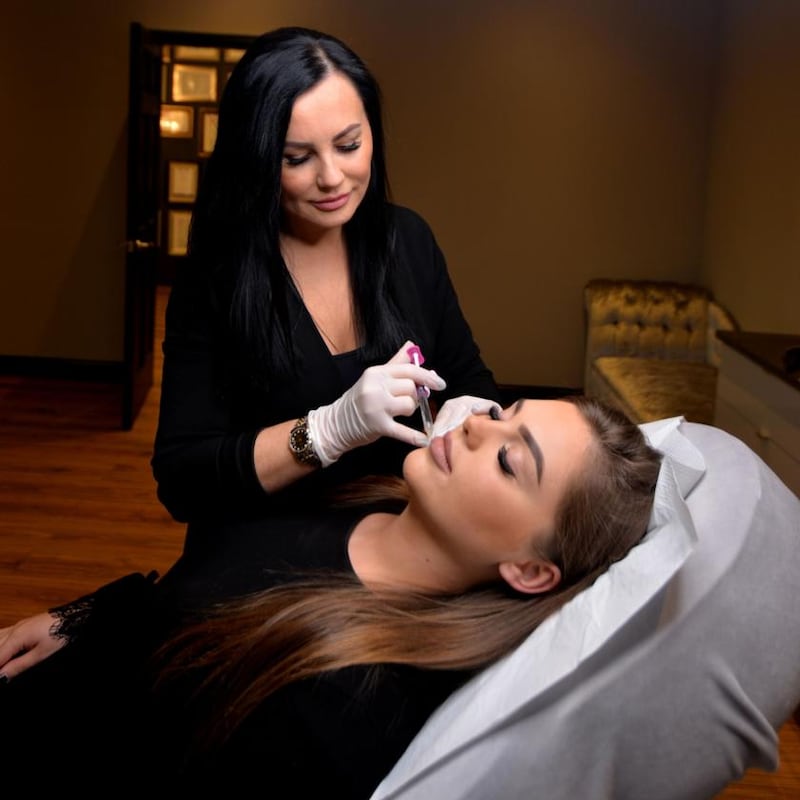A quick Google search of “lip fillers Dublin” will yield more than 500,000 results, but you don’t need to research fillers online to find evidence of their increasing popularity. A stroll through the centre of the capital is its own research – fillers are everywhere; you can quite literally see them on people’s faces.
The American Society of Plastic Surgeons’ 2016 report indicated a 50 per cent increase in lip augmentations in the 18 to 55-plus age range between 2000 and 2016, but attitudes have changed as much as beauty standards in that time. More than ever before, injectables such as Botox and dermal fillers, commonly used to smooth wrinkles, are considered unexceptional forms of personal grooming, a bit like dying your roots or teeth whitening.
People used to visit a plastic surgeon with a photograph of a celebrity they wanted to emulate, but now they ask to look like a digitally enhanced version of themselves
An era can be retrospectively recognised by its beauty standard. The pin-thin eyebrows and matte skin of the 1990s are as redolent of that decade as the poker-straight hair and frosted eyeshadow are of the early 2000s. Today's aesthetic is the "Instagram face". You know it – it was Kylie Jenner's face first, but she has since lost intellectual copyright as the impossibly filtered, full-lipped look has exploded in global popularity, despite Jenner publicly claiming to have medically removed her fillers last year.
Instead of the liquid silicone traditionally used in cosmetic procedures, hyaluronic-acid-based dermal fillers are now standard. Since hyaluronic acid is a compound found naturally in the body, it poses far less risk when injected into the lips than silicone, which stays permanently, and is much more likely to cause an allergic reaction or other complications.
Hyaluronic acid attracts up to 1,000 times its weight in water, giving an instant plumping effect when injected into the lips or face. The body breaks it down naturally, generally over the course of five months to a year in lips, so repeat visits for top-ups are necessary to maintain the results. Lip fillers at a reputable clinic cost upwards of €300 per visit.
Before such fillers became popular, cosmetic augmentation other than Botox usually involved surgery, and was just too expensive for most young people. The ubiquity of safer products in recent years has democratised non-surgical cosmetic procedures such as lip fillers. Augmentation is no longer the exclusive privilege of the wealthy, or those over 40 years old.

People used to visit a plastic surgeon with a photograph of a celebrity they wanted to emulate, but now they are going in with filtered selfies and asking to look like an impossibly unrealistic, digitally enhanced version of themselves.
A 2018 report published in the Journal of the American Medical Association found that the "angle and close distance at which selfies are taken may distort facial dimensions, and lead to dissatisfaction", adding to the desire to enhance their features in real life.
With changing preferences and attitudes toward non-surgical augmentation, the Irish industry has expanded to meet demand from a generation of young women (and some men, too), with clinics offering fillers all over the country.
Research out of Cork University Hospital in 2017 found that Ireland was the global leader in online searches for lip fillers, coming third for Botox searches. It also noted a correlation between online searches for cosmetic procedures and the number of people getting cosmetic work done.
Many vendors offering fillers are not properly qualified to do so, and botched jobs are disturbingly common. Legally in Ireland, Botox must be administered by a doctor, which is generally why bad Botox jobs are rarer.
A lot of incompetent practitioners – those who fly into Ireland for a day and then back out again, those who go door to door, those who have no fixed premises or website – operate more or less in the dark, and are long gone by the time complications arise.
A search for cheap fillers online will throw up various worrying deals – a discount voucher for €99 lip filler at a Limerick vendor; a salon in Cork providing three areas of Botox and a millilitre of lip filler for €450.
FDA (the US's Food and Drug Administration) approval is the gold standard for these products. CE certification, which relates to production standards and not to efficiency, tells you less.
Cheap fillers that haven't been approved by the FDA can be bought easily online from China. These are often the products advertised by disreputable vendors at a fraction of the cost of high quality, traceable products purchased directly from registered pharmaceutical manufacturers or distributors.
Filler is categorised as a medical device, not a drug. Only a doctor can administer Botox, but theoretically, anyone at all can administer filler
Richard Hanson, a consultant plastic surgeon based at the Hanson Clinic and the Mater hospital in Dublin, says regulation in Ireland is poor, but the primary issue is with the law.
“Filler is categorised as a medical device, not a drug,” he says. “Only a doctor can administer Botox, but theoretically, anyone at all can administer filler.”
According to Hanson, those without proper training – a medical background and specialised training in administering fillers – are simply not equipped to deal with the possible complications that can arise. These include infection, inflammation, filler migration and loss of function in the lips. Sometimes, surgery is needed to counter the effects. Hanson has even encountered tissue death in the nose caused by badly injected filler blocking an artery.
Training courses in injecting fillers can vary in duration from a weekend to weeks, but quick training courses are not in themselves a problem, Hanson says. In the case of a doctor who has training in the anatomy of the head and neck, with a skillset developed over time, training in administering particular fillers need not be lengthy to be thorough and responsible.

Alicja Puk, better known as "Alicia lipfiller", is increasingly recognised as the woman to visit for lip fillers in Dublin. Her clinic in Blanchardstown is beloved by young women who desire the Instagram aesthetic, and Puk's own Instagram and Facebook pages are full of heavily filtered photographs of fuller-lipped young women – and their glowing reviews of her work.
Puk, who has been administering fillers for the last four years, won the Irish Beauty Industry Award for enhancement specialist of the year in 2017. Though her background is in cosmetology (the study and application of beauty treatments), she argues that administration of fillers need not be limited to medical professionals, as long as medical professionals provide the training.
“I’ve been trained by doctors in the best training academies with the newest … techniques, in face anatomy, hygiene procedures, skincare, safety,” she says.
Puk claims that she never receives complaints, and has clients come in “every day very upset and hopeless about their lips”, which have been poorly filled “by nurses or doctors. I fix them up.” She believes the push to regulate the administration of fillers is motivated by a desire among other vendors in the industry to oust successful practitioners such as herself.
When fillers are done by someone who doesn't really know what they are doing, it can result in permanent deformity and the need for plastic surgery
But Ronan Butler, clinic director at Amara Clinic on Merrion Square since 2017, argues that regulation is sorely needed. Butler previously worked for Allergan, which produces Botox and the dermal filler known as Juvéderm. He says Amara receives at least 10 emails weekly from Chinese companies offering non-FDA or non-CE approved products, sometimes at prices as low as €30 a syringe.
The clinic also receives frequent email queries about fixing botched work done by other practitioners. Butler says that it often isn’t safe for Amara doctors to attempt to dissolve these sorts of fillers, because in most instances, the patient doesn’t even know what is in their lips.

“Dissolving agent is a serious pharmaceutical product,” Butler stresses. Hyalase, an enzyme that breaks down hyaluronic acid filler, “actually breaks down integral hyaluronic acid too, so usually patients need more dermal filler afterwards. Allergy to hyalase also isn’t unheard of, so it isn’t just a straightforward matter of getting poor quality fillers dissolved.”
Although anyone can administer fillers, only a doctor or a specially trained aesthetic nurse can administer hyalase to dissolve them.
“Botox is actually way safer than fillers,” Butler says. “In most cases, incompetently administered Botox will result in temporary consequences for the face - asymmetry and so on – but this only lasts a few months. When fillers are done by someone who doesn’t really know what they are doing, it can result in permanent deformity and the need for plastic surgery.”
Botox is the most popular treatment at Amara, with dermal fillers coming in at a close second. Seventy per cent of clients at the clinic are educated professionals between the ages of 28 and 50. Their flat fee for dermal fillers is €500, which prices out most young people, but doctors at Amara are instructed to question anyone under 26 who visits the clinic with special rigour. One in every 11 patients were turned away last year.
The clinic seems to be one of the more conscious ones when it comes to the influence of social media on patient preferences. It doesn’t see this influence as inherently problematic, but stresses to patients that this sort of selfie-ready look is not always possible to achieve safely, while maintaining the integrity of a client’s natural appearance long term.
In their consent forms, Amara discreetly screens for body dysmorphic disorder (BDD), a mental health condition most common in teens and young adults, characterised by obsessive focus on flaws in appearance which are often unnoticeable to others. BDD sufferers experience significant distress and anxiety, isolate themselves, and often obsessively seek cosmetic procedure after procedure to “fix” the physical characteristics they dislike about themselves.
Amara screens by querying how patients expect to feel after their treatment, how much time they spend thinking about the physical attribute they have come to the clinic to augment, and other similar questions. Patients with BDD have to be avoided by clinics, Butler stresses, “in part because their psychological issues are just better addressed in other ways – the treatment won’t help. But also, the condition is such that the patient will not ever be happy with the results they get – they can’t be – and they will keep coming back, asking for more.”
Dr Louise Clarke, a chartered psychologist at the Consulting Clinic in Dublin 2, has worked in the UK at London's Priory Hospital as part of a team specialising in BDD. She argues that much more rigorous screening for the disorder is needed.

“Cosmetic procedures can be effective for a lot of people but there are serious risks involved with unlicensed, non-medics administering such procedures, which could [entail] both physical and psychological risks… such procedures should only be administrated by medics, and thorough psychological risk assessment should be carried out before and after to ensure the patient is supported.”
For vulnerable people, Clarke argues, injectables can be “a surgical starting point”. In their cases, “the desire for and pursuit of the procedure is a symptom of an underlying condition – it cannot solve the problem, inevitably leading to increased appetite for more procedures, because ‘the next one will fix it’, but of course it never does.”
There is nothing inherently unhealthy about desiring to change aspects of your appearance. But it is the unscrupulous and unqualified practitioners who don’t take the time to check why people are using their service that are more likely to have younger and more vulnerable people knocking on their doors with unrealistic expectations.
It isn’t as straightforward as choosing a doctor to administer your fillers, either. A GP can legally inject Botox, but that doesn’t mean they have any detailed knowledge of what they are doing.
When it comes to choosing a reputable vendor, there is onus on the consumer too, Ronan Butler argues. “A person looking to have fillers needs to check carefully that a vendor is legitimate. I would never visit a doctor for a procedure like this without background checking them. The most reputable vendors are using FDA approved product. Every vial… is traceable back to the batch it came from.”
It is indisputable that some vendors are cutting ethical, financial and professional corners in order to provide cheap services to customers who can’t afford or are disinclined to pay for fillers from a legitimate, professional source. However, confusion among consumers is rife and understandable – illegitimate vendors profit from the grey area around what constitutes a qualification and what does not.
In the absence of any obligation to declare what qualifies them to administer dermal fillers, vendors can advertise their services without advertising their qualifications, and many consumers will just presume they are legitimate.
All my friends have had something done, and very few of them openly confess it, but attitudes are changing. I think it will become as normal as teeth whitening
In researching this article, almost every non-medical professional who administers fillers contacted by The Irish Times refused to speak about their work, or even confirm that they use fillers. We spoke with several women who have had cosmetic work done, including fillers, and none except a handful in their early 20s would speak on the record about it.
Though attitudes are changing among members of iGen, or Generation Z, for whom an obviously augmented face is a status symbol, there is still a pervasive silence about cosmetic work among those in their late 20s and older. Journalist and editor Liz Dwyer, who has always been honest about her cosmetic procedures, and has been writing about the industry for years, believes we could all benefit from greater openness about having cosmetic work done.
“All my friends have had something done, and very few of them openly confess it, but attitudes are changing,” she says. “I think it will become as normal as teeth whitening.”
More openness about non-surgical cosmetic work could ultimately be beneficial for the consumer too. The more we talk about it, the more informed and discerning consumers will become, forcing vendors to become more accountable and making it more difficult for the industry to continue unregulated.
WHAT YOU SHOULD CHECK IF GETTING FILLERS
1 FDA approval attests to safety and efficacy. Check with your vendor whether the filler is FDA approved. Ask to see the packaging if you are unsure.
2 Avoid deals and discounts. Fillers and the expertise to administer them safely are expensive. If a deal seems too good to be true, it is.
3 Be wary of any vendor who is willing to administer fillers without a separate consultation appointment in advance.
4 Choose a vendor with a set location, such as a clinic. Avoid vendors who do not have a permanent address or will be unavailable for follow-up questions or concerns.
5 Check the practitioner's qualifications. If possible, choose a medical professional; if something goes wrong, they will be equipped to help and can dissolve the fillers later if needed.















